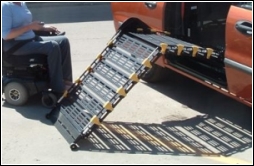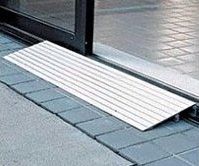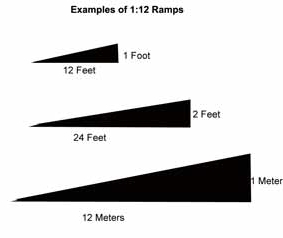Handicap ramps can be a vital part in the life and recovery of those who are in need. Handicap ramps are especially designed for use in bridging gaps in multi-level entryways or areas of homes or offices which may only be entered through steps or stairs. Placed in each opening or doorway, the ramp allows the user access to a particular room or area which would normally prove impassible for those who require the use of a wheelchair or a scooter.
 The benefits of using of a ramp over other options are numerous. The application of a handicap ramp in the home or business, used by those who are in need, can make the ease of movement and progression of mobility, a certainty. For those who use a wheelchair, the freedom of movement that a wheelchair ramp can provide, means that the user has the consistent ability to move about their home or office with confidence. A more independent user will enjoy the freedom of choice which comes from simply having this mobility.
The benefits of using of a ramp over other options are numerous. The application of a handicap ramp in the home or business, used by those who are in need, can make the ease of movement and progression of mobility, a certainty. For those who use a wheelchair, the freedom of movement that a wheelchair ramp can provide, means that the user has the consistent ability to move about their home or office with confidence. A more independent user will enjoy the freedom of choice which comes from simply having this mobility.
Portable Handicap Ramps
 A fixed or moveable handicap ramp in the home will ensure that the user enjoys an independent care regimen. Entrance equipped with ramps can become wheelchair accessible bathrooms and allow the user with the ability for self care of routine hygienic or personal needs throughout their day. Using a ramp for kitchen access ensures the user the option to cook foods and use the refrigerator. They can make their own decisions on what meals to cook. Ramps placed in doorways for use of outside access greatly improves the user’s sense of security by allowing fast, easy and safe outdoor access in case of emergency.
A fixed or moveable handicap ramp in the home will ensure that the user enjoys an independent care regimen. Entrance equipped with ramps can become wheelchair accessible bathrooms and allow the user with the ability for self care of routine hygienic or personal needs throughout their day. Using a ramp for kitchen access ensures the user the option to cook foods and use the refrigerator. They can make their own decisions on what meals to cook. Ramps placed in doorways for use of outside access greatly improves the user’s sense of security by allowing fast, easy and safe outdoor access in case of emergency.
Check out our List of Best Recommended Portable Ramps
These ramps are useful for doorways, entrances, slightly raised thresholds, raised landings, van and truck entries and even as handicap bathroom ramps. These recommended wheelchair ramps are able to support the demands of a wheelchair user. With all these options, there is no need to make handicap ramp. If you do choose to go the ramp construction route, be sure to follow the ramps specs found below.
- Wheelchair Singlefold Ramp
- Rubber Portable Ramps
- Threshold Aluminum Ramps
- Wheelchair Multi-fold Ramp with Longer Lengths
- Wheelchair Ramp with Carrying Bag
- Aluminum Folding Wheelchair Ramp
 Portable wheelchair ramps may be stored and used both in the home and in public areas where access for handicapped persons may not be available. There is a wide selection of lightweight and removable options for portable ramps. Portable ramps, scooter ramps or wheelchair ramps are great for vehicle access because of the constant handling, removal and installation. Ramps around the home should be permanent whether they are found on the front door or on the shower stall. However, some insurances do not pay for these permanent fixtures. Check with your insurer for more details.
Portable wheelchair ramps may be stored and used both in the home and in public areas where access for handicapped persons may not be available. There is a wide selection of lightweight and removable options for portable ramps. Portable ramps, scooter ramps or wheelchair ramps are great for vehicle access because of the constant handling, removal and installation. Ramps around the home should be permanent whether they are found on the front door or on the shower stall. However, some insurances do not pay for these permanent fixtures. Check with your insurer for more details.
Handicap Ramp Specs
When choosing or building a handicap ramp, make sure it meets the user or your needs. The Americans with Disabilities Act (ADA) has handicap ramps code guidelines that follows for every 1 inch of rise on a ramp, the length should be 12 inches.


 This 1 to 12 ratio is only the minimum requirements allowed by the ADA regulations. If the wheelchair user is limited in upper body strength, a 1:12 slope could even pose a problem. Use a ratio of 1:16 or 1:20 instead. In regards to handicap ramp widths, the minimum ADA requirements states a width of 36 inches. However for some individuals with larger wheelchairs or scooters, a wider width of 40 inches or 48 inches creates a greater turning radius.
This 1 to 12 ratio is only the minimum requirements allowed by the ADA regulations. If the wheelchair user is limited in upper body strength, a 1:12 slope could even pose a problem. Use a ratio of 1:16 or 1:20 instead. In regards to handicap ramp widths, the minimum ADA requirements states a width of 36 inches. However for some individuals with larger wheelchairs or scooters, a wider width of 40 inches or 48 inches creates a greater turning radius.
Handicap ramp costs may be covered for children under the Children’s Health Insurance Program (CHIP). Check with private insurance agencies for details on their coverage. Costs for ramps may depend upon the size, nature and type of ramp you may choose. Choose your ramp based upon your personal needs, wants and means of affordability.
